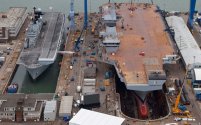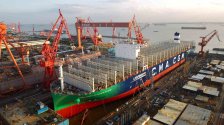QE class has 20m on both ends and Drydock 12 is a bit of an outlier with 2-3m clearance on one end and 320m on the other. Technically like above you can have 2m clearance but building a 362m long ship in a 366m long drydock seems less than ideal doesn't it.I wouldn't necessarily take "spacing between drydock" to be an expected, consistent measure when the sample size is so small.
For example, prior to CV-18, the CV-17 built at Dalian had spacing that was 30m from the bow-most part of the ship to the drydock wall, and nearly 20m at the aftmost part of the ship
Given they're going to be building larger ships in the same drydock, it's more reasonable to surmise that the positioning/spacing of existing ships built so far are simply "under"-sized for what the drydock is able to maximally accommodate.

and if we look at the construction of USN CVNs (in this case a Ford class, USS JFK I believe), they barely have a few meters between the aft flight deck section and the wall of the drydock (the length of the dock means the bow spacing is not a factor), so a spacing of some 10-15m either side seems eminently reasonable.
(That said, I don't really have a horse in the race as to what the actual expected length of DL's carrier will be)

Last edited:








